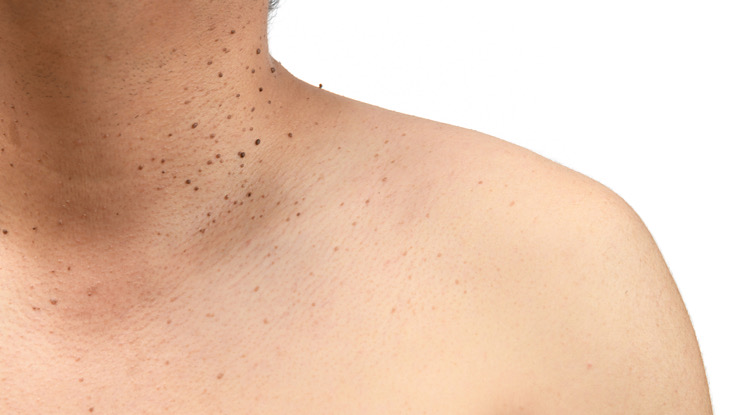
Skin tags, also known as acrochordons, are benign (harmless) skin growth that commonly affects older individuals or those who are overweight. Though benign, skin tags can be quite bothersome. Some individuals with skin tags experience itching and pain associated with their skin tags. These symptoms are common because they occur in skin fold areas such as the neck, groin, and axillary (armpit) region. Some research suggests that skin tags may be passed on in genes. In addition, there is a known association between obesity, insulin-resistant conditions, and skin tags. Continue reading to learn more about the common causes of skin tags.
1. Friction
Many people develop skin tags due to skin rubbing against skin. This is the primary cause of skin tags in the folds of the body, such as the armpits and under the breasts. The friction causes tissue to flap over, creating a small stalk that protrudes from the skin, known as a peduncle.
2. Age
Skin tags are most common for people who are 50 years of age or older. As people age, the skin sags and folds in many areas of the body, leading to increased friction or skin rubbing, producing skin tags.
3. Being Overweight or Obesity
People who are overweight or obese are more at risk for developing skin tags. Excess skin folds create friction on the skin and moisture within the folds of the body. Skin friction is a common side effect of being overweight, ultimately a cause of skin tags on the body, face, neck, and chest.
4. Diabetes mellitus
Individuals diagnosed with diabetes may carry excess weight while balancing blood sugar and glucose levels. As a result, excess skin folds foster the ideal environment for skin tags to form. People with diabetes who are over 50 years of age are twice as likely to produce multiple skin tags because age is also an associated cause of skin tags.
5. Tight Clothing
Tight clothing can restrict the body and cause friction on the skin. As a result, skin tags often form on areas of the body where the clothing is especially tight, such as the waistband or along the edges of a tight bra strap. People who are overweight are especially at risk for skin tags when they wear tight clothing that produces more friction in areas other than the folds of the body.
6. Skin Diseases
People with skin diseases, such as acanthosis nigricans, are more prone to developing skin tags. Some skin diseases produce changes in the pigment of the skin as well as flaps of tissue in the form of a skin tag on the affected areas of the skin.
Skin Tag Removal
Skin tags often appear without warning and are typically harmless. A skin tag consists of a small flap of tissue with a connecting stalk that hangs off the skin. Skin tags are most common in older individuals and typically appear on the face, chest, back, neck, and armpits. Skin tags are caused by several different lifestyle factors that vary from one person to the next. For some, removal may be desired due to aesthetic reasons.
A doctor can remove a skin tag removal. They may use a freezing method known as cryosurgery, a burning method known as electrocautery. Or they could use a simple mechanical removal method using scissors. If you experience severe pain with any existing skin tags, talk to your doctor, as rapid changes and pain accompanying skin tags may be underlying a more serious condition.
Resource Links:
- “Acrochordon” via StatPearls
- “Skin Tags” via AOCD





